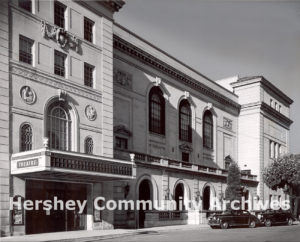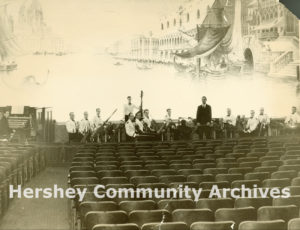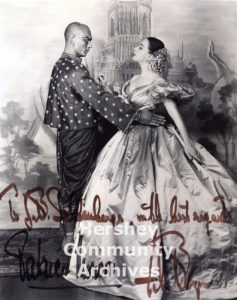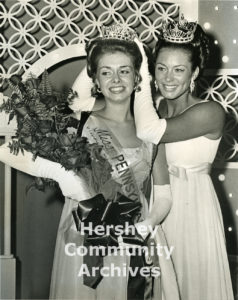Hershey Theatre

Origins of Hershey Theatre
In 1915, Hershey had his architect, C. Emlen Urban, draw up plans for a new community building. As Urban drew up plans for the building, the architect engaged the design services of Tiffany Studios to develop plans for the Theatre’s interior design. The building was to include two theaters, a dining room, cafeteria, gymnasium, swimming pool, assembly rooms, a dormitory and a hospital. Groundbreaking was scheduled for early 1916 but the arrival of World War I delayed the start of the project. Post war financial challenges forced Hershey to tighten his belt and delay community projects. As a result, the architect’s plans were put away and virtually forgotten.
As the 1930s financial Depression overwhelmed the country’s economy, Milton Hershey responded to the economic crisis by initiating a local building program, better known as the Great Building Campaign. Hershey’s building boom provided employment for over 600 workers who otherwise would have been unemployed and built many of this community’s most impressive structures. The original 1915 plans for the Community Building and Theatre were dusted off and workers broke ground in 1928. The plans were closely followed with only a couple exceptions. Plans had originally called for the structure to be faced with light, tan brick. With actual construction, Indiana limestone was substituted. The other significant change to the original plans was that the Theatre did not incorporate the original interior designs created by Tiffany Studios. It is not known why the original plans were not used but may be related to the Tiffany Studios closing in 1930.
Theatre Design
Hershey Theatre was built just about the time that New York City’s Radio City Music Hall was constructed. That performance hall’s stark art deco’s design stands in sharp contrast with Hershey Theatre’s interior. Since the Theatre was built from plans developed 19 years earlier, its design more closely resembles the opulence of early twentieth century theaters. The grand lobby is a lavish entrance to a romantic, European inspired space. Patrons walk into the lobby on floors laid with polished Italian lava rock. Walls are faced with four different types of marble. The lobby walls seem to soar up to touch a ceiling filled with images of sheaves of wheat, beehives, swans, pastoral scenes, the Greek god Apollo and Assyrian war chariots. To enter the theater’s house, patrons pass through solid brass doors to the inner foyer, featuring a much lower ceiling shimmering with an intricate blue and gold mosaic, patterned after St. Mark’s Cathedral in Venice, Italy. Two German artisans labored for two full years to create the beautiful ceiling.
In the main auditorium, the Theatre’s European inspired design creates a sense of being in Venice, Italy. Pink granite walls, faux balconies and windows create the illusion of being outside in a plaza. The six-ton fire curtain features a painting of the city of Venice, with its Grand Canal slowly flowing past Doge’s Palace. The overhead proscenium arch is inspired by the design of Venice’s Bridge of Sighs, an ancient canal bridge.
The Theatre’s ceiling was specially constructed to enhance the sense of being in an outside space. Through the use of a suspended ceiling, star-like lights shine through small openings in the ceiling. Colored lights permit the Theatre’s “sky” to change from dawn to day to dusk. The Theatre also makes use of a stereoptican machine that projects moving clouds onto the ceiling. Such atmospheric ceilings were a hallmark of early 20th century grand theaters.
As was expected of such a grand performance hall, the Theatre features a four-manual 78 rank Aeolian-Skinner concert organ. Milton Hershey wanted to have an organ that would match the Theatre’s elegant design. He asked Charles Ziegler, President of Hershey Estates, to select and purchase a suitable organ. Ziegler, a fine amateur musician himself, called in Dr. Harry A. Sykes, a noted Lancaster organist and composer, to assist with the decisions surrounding the type and maker of the organ. The organ’s more than 4,715 pipes and 25 bells are concealed behind the french doors of the front balconies facing either side of the stage.
Hershey Theatre Opens
Hershey dedicated its new Community Building and Theatre during the thirtieth anniversary celebration of the town held September 1-4, 1933. Dr. Sykes returned to Hershey to offer a grand organ dedication and recital on Friday, September 1. The next day, Saturday, was the Community Theatre’s official opening day. The program, a popular movie with a vaudeville revue was offered three times during the day. The first movie shown at the theatre was “Pilgrimage” with Henriette Crosman, Norman Foster, and Marion Nixon. The vaudeville show featured nationally popular singers, comediennes, dancers and acrobatics. The show also featured “The Hersheyettes,” sixteen dancing girls performing precision routines. Sunday, September 3, 1933, the celebration was a bit more serious with then Secretary of Agriculture (later Vice-President of the United States) Henry A. Wallace offering remarks at the official dedication ceremony. The Theatre was overflowing, necessitating loudspeakers to carry the message to the crowd outside. The gala weekend festivities concluded on Labor Day with three more movie/vaudeville performances.
Backstage at the Hershey Theatre
Though the front of Hershey Theatre’s house is magnificent, its heart lies backstage, behind the footlights. The stage measures 76 feet wide from wall to wall, and 45 feet from the back wall to the front apron. Built into the floor are sets of elevators which can rise to a height of seven feet; the rear elevator can also be moved below stage level to permit the transfer of scenery to and from storage. The elevators can be stopped at any level to provide a variety of settings and platforms for plays and musical attraction. Attached to the underside of the front elevator is the Theatre’s sound system used for movies. When Hershey Theatre presents movies, the screen, on a 3-ton steel frame measuring 18’x44’6″, is lowered from the ceiling directly in front of the gigantic speakers. Sound is projected through the screen toward the audience through millions of tiny holes in the specially coated vinyl screen.
For theatrical productions Hershey Theatre provides 49 counter weighted lines for sets and lights. The system was updated in 2004 from the original 39 lines to a double purchase system to increase the number and capacity available to visiting productions. These lines permit a stagehand, or “flyman,” to lower the battens (pipes) onto which the various backdrops and sets are attached. Steel counterweight is added equal in weight to backdrop, sets or lighting allowing a single stagehand to change scenes by “flying” the battens in and out to their appropriate spot with relative ease. In addition to being able to handle more weight, the new system came with the added bonus of taking up less stage space in the wings allowing larger productions to be seen here in Hershey.
The stage and atmospheric lighting at the Theatre is controlled by 288 electronic dimmers and a computer light board installed in the late 1990’s replacing a 2 scene preset board that was in place since 1977. The Theatre’s original switchboard had been used continuously, modulating the lighting in show after show since 1933. When it was finally retired, it brought only $187 and was labeled as scrap. At the controls, the Master Electrician now uses one finger to control what use to take two hands, knees, a chin and at sometimes another operator.
In the spring of 1981, a new and complete house sound system was installed in the Hershey Theatre. At that time, the system was described as “state of the art” and included revamping the sound amplification to all seating areas. Two 2-way speakers mounted on the sides of the proscenium opening are focused on the front and middle orchestra section, with additional speakers for the rear orchestra positioned behind the overhead lighting fixtures. A custom three-way center speaker cluster built into the proscenium serves the loge and lower balcony seats, while speakers mounted flush with the ceiling amplify the sound for the middle and upper balcony areas. The house (auditorium) speakers are controlled by a complex system which was updated with digital technology in 2006 and includes a 24 channel audio board, and delays that time the speakers signal by milliseconds in accordance with their distance from the stage so that the sound seems to emanate from the stage.
These systems or, “house system,” often play a supporting role for the traveling shows. Since theatre’s vary in the quality of their in house sound and lighting systems, most shows travel with their own sound and lighting systems. Hershey Theatre patrons attending a traveling show might notice additional speakers on the sides of the stage, as well as sound mixing consoles and Audio Engineer, computer light boards and operators working from a location behind the rear orchestra wall.
When the building was first constructed, five stories of dressing rooms were provided for the traveling performers, many with a private tub and/or shower. On the first floor is the “green room,” a theater tradition which dates back to the days of vaudeville when entertainers needed a place to relax and unwind between performances. Today, this room is usually used as a wardrobe department where garments are pressed and mended during the stay of theatrical presentations.
Restoring an Architectural Gem
By the end of the 20th century, Hershey Theatre was showing its age. For years smoking had been permitted in the lobbies and auditorium. All the hard surfaces, ceilings and walls were smoke stained. Original paint colors had been lost over the years and the grace and beauty of the architecture was obscured by modern color choices.
Recognizing the building’s historic beauty, The M.S. Hershey Foundation committed three million dollars over three years towards restoring the Theatre to its original beauty. The restoration project began in 2000 and touched every room in the Theatre, from the front lobby and the dressing rooms to the auditorium interior and ceiling.
Albert Michaels Conservation, Inc. (AMC) of Harrisburg was hired to handle the intricate and delicate work of restoring the building’s decorative finishes, murals, marble and stained glass. Their work involved historic paint studies to accurately determine the original vision for the space. Throughout the Theatre the original gilded finishes were cleaned and restored using a complex application of gold leaf, bronze powders and Dutch metals.
Carpeting was replaced throughout the building and in the auditorium all the original seats were rebuilt from the springs out. Public restrooms were modernized and expanded.
The back of the house was not ignored. The dressing rooms were painted and carpeted, and lighting fixtures were installed. New speakers were added to the dressing rooms along with an updated paging and phone system.
More than Meets the Eye: The Symbolism of the Grand Lobby
Hershey Theatre is much more than a beautiful building that brings a wealth of music and theatrical performances to our region. The building’s interior is intended to transport patrons to the world of the arts. Patrons begin their journey as they step into the main or Grand Lobby which is decorated with artistic motifs related to the ancient legacy of the performing arts.
Entering the Grand Lobby visitors’ eyes are immediately drawn upwards toward the soaring ceiling. The lobby’s interior design is suggestive of an ancient Greek temple dedicated to the god, Apollo, the patron god of Music, Poetry and the Arts. As such, the Theatre’s Apollo is often depicted holding a lyre.
In the Grand Lobby, Apollo is portrayed driving his horse drawn chariot, pulling the sun across the sky. This image is repeated four times in the ceiling. Ancient Greeks believed the sun rose in the morning when Apollo attached the sun to his chariot and rode across the sky all day. In the evening the sun set as Apollo retired for the day. Hershey Theatre’s Apollo is shown with sunrays shining out from under a cloud.
The Lobby ceiling includes other symbols of Greek mythology. Apollo’s twin sister, Artemis, was the patron saint of animals, so Apollo also held animals in high esteem. He was the patron defender of herds and flocks, which may explain the sheep in the corners of the ceiling. When horses were not drawing his chariot, he would use swans, dolphins, or griffins, a half bird/half lion mythological creature. All these animals are featured in the Theatre’s interior design. Swans played an important role in the mythology surrounding Apollo. At the time of his birth swans surrounded the island on which Apollo was born. In the Grand Lobby swans sit at each end of the barrel-vaulted ceiling, two swans flanking a lyre. In the two large, white panels in the center of the ceiling, four golden swans form a square. Each pair holds a ribbon of fabric draped between their beaks. Swans can also be seen in the outer lobbies near the ticket windows, in the lower lobby and in the northern lobby, also known as the “Swan Lobby” for its images of swans found in the ceiling and on the light fixtures.
The Grand Lobby ceiling decoration also includes two dolphins. According to Greek mythology, when Apollo was searching for someone to look after the island of Delphi (his birthplace and the home of his oracle), it was said that he transformed himself into a dolphin and threw himself onto the deck of a passing ship. The sailors instantly threw him back into the sea. He repeated this three times and the sailor’s reaction was always the same. Their concern for the dolphin convinced Apollo that they would take good care of his island and the oracle. Apollo revealed himself to the sailors and told them of their new destiny. They happily accepted and became the priests of Delphi. Four griffin-like creatures are also part of the ceiling’s design, although the most elegant griffins are gilded inside the Theatre in the stairwells on the balcony level.
Along both sides of the lobby’s ceiling are six teal triangular shapes. Shown within them are beehives and sheaves of wheat. The beehives are important because Apollo’s son Aristaeus was the beekeeper for the Gods and harvested all of the honey they drank on Mount Olympus. The wheat is representative of Apollo’s role as the god of crops. The ceiling also boasts pictures of some of the Muses, perhaps because their choir was directed by Apollo.
While most of the images in the lobby’s ceiling can be related to Apollo, there are still images of people, palm trees and medallions that go unexplained. Perhaps in another 75 years we’ll know the whole story.
Hershey Theatre and the Performing Arts: The 1930s
From its inception, Hershey Theatre was an enigma. In 1930, Hershey boasted a population of less than 2,500 residents. Some people questioned the wisdom of building a 1,904 seat theater in the heart of rural central Pennsylvania. How could such a small town sustain a theater that would often be compared to Radio City Music Hall? Hershey Theatre succeeded by being part of Milton Hershey’s plan to make Hershey into a popular tourist destination, offering a broad range of cultural and recreational attractions.
Hershey Theatre became a regular stop on the vaudeville circuit. Vaudeville, which was one of the primary forms of entertainment in America from the 1880s through the 1930s, featured a bill of performances each evening that was made up of a series of separate, unrelated acts. This variety-act based entertainment was center stage at Hershey Theatre from 1933 through 1938.
During those vaudeville years, such notable entertainers as Blackstone the Magician, Roy Rogers, Mr. and Mrs. Tom Thumb, the Roxyettes (forerunners of the Rockettes), Fanny Brice, Ed Wynn, Ethel Barrymore and Jackie Cooper took their star turns on Hershey’s stage. These acts were usually combined with the Hersheyettes, 16 precision dancing girls, who appeared regularly on the stage.
Community programs were held regularly during this period. On Sundays, the community was invited to hear special music, a devotional period, and an address.
The 1940s
With the passing of vaudeville, first-run movies became Hershey’s passion. In fact, during 1943, 213 different full-length pictures were shown. During the 1940s, Broadway touring companies came more regularly to Hershey, with shows like The Student Prince, Arsenic and Old Lace, My Sister Eileen, The Corn is Green, Annie Get Your Gun, Carousel, Show Boat, Harvey and Oklahoma! With the shows came the stars of Broadway and Hollywood, including Tallulah Bankhead, Jack Haley, Basil Rathbone, Zasu Pitts, Jack Gilford, and the amazing theatrical couple, Alfred Lunt and Lynn Fontanne.
The 1950s
By the 1950s, Hershey Theatre was an established and sought after venue for Broadway tours. In fact, in 1954, the first stop of Yul Brynner and The King and I – after their triumph on Broadway – was Hershey Theatre. During those golden years, the stars came with regularity, including Katharine Hepburn, Jeanette MacDonald, Olivia de Havilland, Ethel Waters, Van Heflin, Janet Blair, Rex Harrison, Mary Martin and Celeste Holms. The 1950s, also saw the start of the love affair between Hershey Theatre and two of their favorite performers: Fred Waring, who appeared 21 times and Victor Borge, who appeared 11 times.
The 1960s
The parade of stars continued in the 1960s, with entertainment legends Joan Blondell, Imogene Coca, Edward Everett Horton, Forrest Tucker, Ed Ames, Ginger Rogers, Don Ameche, Tab Hunter, Margaret O’Brien and Robert Preston coming to town. During the 1960s, more classical attractions came as well, including the Philadelphia Symphony Orchestra, pianist Van Cliburn, Chicago Symphony Orchestra, the Roger Wagner Chorale, the Vienna Choir Boys and the Pennsylvania Ballet.
From 1964 through 1974, Hershey Theatre was home to the Pennsylvania Scholarship Pageant, part of the Miss America family. The pageant was a community affair as the contestants stayed in local homes and each woman had a local resident serving as her chaperone. It became the first state pageant to be televised, beginning in 1966.
Hershey’s strong program of first-run movies took a turn for the worse during the 1960s. Due to a strong family-movie-only stand taken by the Theatre, distributors took first-run films elsewhere, bringing only second-runs to Hershey. The Theatre’s popularity diminished, and vandalism and mischief increased, with much of the audience now young children and teens left alone at the Theatre. In 1969, the Theatre discontinued showing movies as part of their regular fare.
The 1970s
In 1970, Hershey Estates transferred ownership of the Theatre to The M.S. Hershey Foundation. With the change in leadership, the Theatre renewed its commitment to the arts and began building a program that offered a wide variety of musical and theatrical offerings. The Great Artists Series, which Hershey Theatre presented with partners Lebanon Valley College and Elizabethtown College, continued to bring world renowned classical attractions to central Pennsylvania, including the London Philharmonic, Duke Ellington, violinist Yehudi Menuhin, Berlin Concert Choir and Orchestra, pianists Lorin Hollander and Andre Watts, Moscow State Symphony Orchestra, Dave Brubeck, Norman Luboff Choir, guitarists The Romeros, Marcel Marceau and the Prague Chamber Orchestra – just to name a few.
Stars included Robert Cummings, Mamie Van Doren, Louis Jourdan, Stubby Kaye, Ricardo Montalban, Myrna Loy, Edward Mulhare, Patsy Kelly, Howard Keel, Ken Berry, Dana Andrews, Monte Markham, Howard Duff, Cyril Ritchard, Carolyn Jones, Rosemary Clooney and Rose Marie. A favorite of this era was Broadway star John Raitt (father of Bonnie Raitt), who visited six times. In March 1975, the show Give ‘Em Hell, Harry starring James Whitmore, was built in Hershey for their road tour. In 1979, the Classic Film Series began, brining vintage films back to the Theatre once each month.
The 1980s
The 1980s saw the Theatre rise in prominence on the touring Broadway circuit, as such shows as Annie, A Chorus Line, Sweeney Todd, Peter Pan, Amadeus, Evita, Joseph and the Amazing Technicolor Dreamcoat, 42nd Street, Camelot, Dreamgirls, Big River and CATS came to town. There was no shortage of star power, as Shari Lewis, Jane Russell, Richard Harris, Robert Goulet, Leslie Uggams, Dizzy Gillespie and Billy Eckstine came. During this decade, crooner Mel Torme visited five times.
The 1990s
The end of the century saw no end to the star power on the Hershey stage, with such luminaries as Michael Feinstein, Yo-Yo Ma, Mandy Patinkin, Carol Channing, Rita Moreno, Wynton Marasalis, George Shearing, Joe Williams, Larry Gatlin, Jerry Lewis, Della Reese, Petula Clark, David Cassidy, John Davidson, Donna McKechnie, Andrea McCardle and Marvin Hamlisch. Shows such as Les Miserables, Guys and Dolls, The Secret Garden, Will Rogers’ Follies, Crazy for You, State Fair, An Inspector Calls, Stomp, Smokey Joe’s Café, Jolson, Chicago, Fame, Sunset Boulevard and Footloose were presented. During this decade, the Theatre started offereing full week runs of touring Broadway shows – eight performances during each one week stay.
A New Century, A New Millenium
Since 2000, Bill Cosby, James Galway, Rich Little, Savion Glover, Cherry Jones, Valerie Harper, Julie Harris, Frank Gorshin and George Carlin have entertained audiences at Hershey Theatre. Shows such as Scarlet Pimpernel, Copacabana, The Civil War, The Music Man, Fosse, Kiss Me Kate, Bring in da’ Noise, Bring in da’ Funk, Riverdance, The Full Monty, Thoroughly Modern Millie, The King and I, RENT, Big River, Beauty and the Beast, Hairspray and Movin’ Out continue the tradition of bringing the best of Broadway to Hershey.


